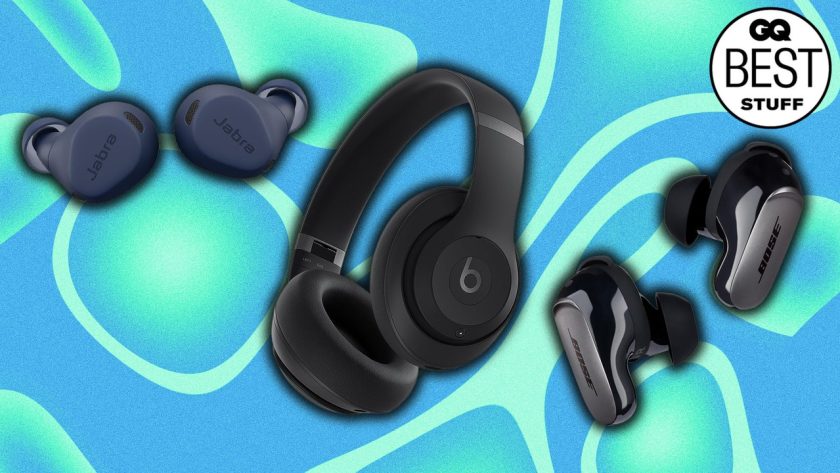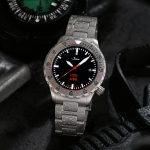These are essentially the successors to the Beats Studio3, which we liked for their ANC capabilities, and these perform even better, so you can ignore the guy on the weight bench next on you over-exerting himself on a chest press. Another reason we like the Studio Pros is because of their tactile buttons. While a pair like the Bose 700 headphones utilize touch, the actual buttons on the Studio Pros make it easier to change the volume or switch songs if you’re trying to do it mid-move. Also, the bass-heavy of the Beats are apt at boosting your favorite rap or rock socks, which are typically the bops you blast while working out.
The Best Workout Headphones for Biking or Running: Shokz Openfit
If you’re a city biker, you know that using any pair of headphones while you’re riding can be dangerous. You need a ton of spatial awareness to safely navigate all the trucks, cars, pedestrians, and other bikers zooming around the streets. The simplest way to address the problem of quiet commutes while biking is with a portable Bluetooth speaker. But if you don’t want your entire neighborhood to know you’re still listening to the Carly Rae Jepsen album from 2019, you have other options. One of the latest and greatest models is from Shokz, its Openfit headphones. The fit here is very similar to Beats’ popular Powerbeats Pro earbuds, which hook around your ear for greater stability during a sprint or bear crawl, and also come in a tank of a charging case. Our tester, an avid fitness enthusiast and runner, called these out in this year’s Fitness Awards for their above-average workout-quality audio and sweatproof exterior. Critically, there’s also the stellar directional audio which pumps sound into your ears without sacrificing spatial awareness on a busy road or trail. Get these if you’re sick of other earbuds losing suction or slipping out during a spin around the block or a rapid movement workout.
5 Other Wireless Headphones We Like for Working Out
AirPods, Pro or otherwise, aren’t generally our favorite workout headphones. Something about the fit, like that little tail, just don’t feel very secure. On the bright side, Apple’s AirPod Pros 2 added an extra set of ear tips so that more people could get a more tailored fit, and the in-ear fit can be tested directly on your phone to make sure you opted for the right size for your ear canal. Even the second-generation Apple AirPods Pros with their new extra-small silicone tips feel like they might jump out of your ear while you’re mid-stride. Their IPX4 makes them sweat- and water-resistant, so they can hold up against a less-rigorous workout, but if you’re already an Apple user, go ahead and stick with brand loyalty. Six hours of battery life feel inadequate, and while we don’t think you’ll be working out for six hours straight, it does require more charging sessions (wireless charging is an option, at least!). On the other hand, as regular wireless headphones, these are great with much better active noise cancellation than the OG AirPods Pros and an adaptive transparency mode that feels somewhat like witchcraft.
Shokz is also a proponent of bone-conduction headphones, which have speaker pads that rest on your temples instead of in or around your ears. You pick up some of the sound through your outer ear, but the majority of the sound travels through the bones of your jaw in the form of vibrations to your inner ear. The result is a pretty hollow sound, leagues away from the high-fidelity experience of something like the Jabra Elite 7 Actives, but it’s plenty good enough for listening to talk-y podcasts. And, more importantly, you can listen to those podcasts while also hearing literally everything else around you. Other advantages? The OpenRun headphones are light, have a decent eight-hour battery life, are fully waterproof, and come with a two-year warranty. If you’re looking for headphones for your bike workouts and commutes, this is another safe option.
If you have an iPhone, you get Airpods; if you have a Samsung, you go for the Galaxy Buds. In this case, you go for the Galaxy Buds 2 Pros when you need something to work out in. These are smaller, fit better than the previous model, and boast better sound quality than a lot of other headphones on this list. But the problem is that some of these earbuds’ best and most essential features—like noise controls and earbud insights—are reserved for those with a Galaxy device as the companion app is only available on Android devices (sorry, iOS users). Though if you’re already tapped into the Samsung tech-sphere, these are a worthwhile pair of workout headphones.
JBL has gained a reputation for its high-quality sound, a factor that rings true with the brand’s Live Free 2. Its IPX5 rating isn’t as good as our top pick’s, but if waterproof abilities aren’t at the top of your list that shouldn’t be an issue. And while the Live Free 2s retail for $150, they’re typically found for way less, hovering in the $75 to $100 range, putting it in line with our top-pick Jabras. If you’re not using active noise cancellation, these earbuds boast an impressive 10 hours of battery life, and the fit is standard—nothing to write home about.
LG doesn’t have a lot of clout in the headphone game, but its LG Tone Free TF8, a 2022 release, include some worthwhile features that make these earbuds worthy of this list. They boast something called “SwivelGrip” technology, which is just a glorified way of saying the wing tips will stay securely in your ear—something it does surprisingly well. Their matte finish is nice, but the case they come in is small but bulky enough that it juts out strangely in your pocket. Another impressive feature lives in their case: a bacteria-killing light called UVnano+ that’ll help kill any funk on your earbuds. The UVnano+ only works on the gel tips, and it’s only active when you’re charging (wireless or otherwise) the headphones, but it’s a nice touch that’ll please any germaphobe who is prone to dropping their buds on the dirty subway floor.



